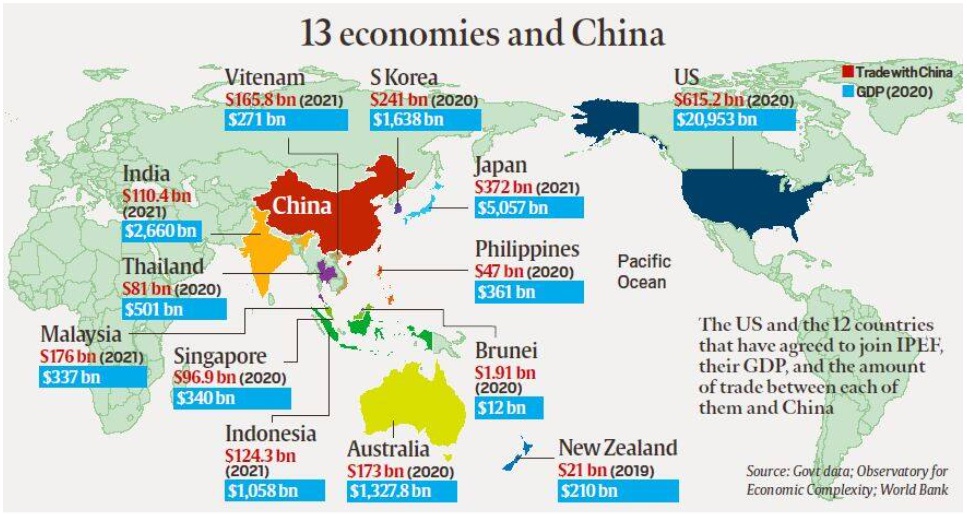Monday, 30th May 2022
GST rates Restructuring
In News
The GST regime is about to complete five years in July and is due for an overhaul in tax rates levied on different products.
Need for the restructuring
- For Businesses: The tax rate slabs are too many, compounded by aberrations in the duty structure through their supply chains with some inputs taxed more than the final product.
- Due to this, the inherent benefit of the simplicity of GST tax regime is foregone.
- There are five broad tax rates of zero, 5%, 12%, 18% and 28%, with a cess levied over and above the 28% on some ‘sin’ goods. Special lower rates are levied on items like precious stones and diamonds.
- For Central Government: The government has been suggesting that the tax returns have been low. GST was introduced in the hope to simplify the tax structure to bolster compliance.
- But the revenue-neutral tax rate has been coming down since the beginning of GST regime from 15.5% to 11.5%.
- This has been due to tax rate cuts approved by the Council on the eve of critical elections.
- For States: At the time of GST implementation on July 1, 2017, the Centre had agreed to compensate states for five years till June 2022, and protect their revenue at 14 per cent per annum over the base year revenue of 2015-16.
- As the compensation is due to end, the fiscal space of these states will depend on actual collections thereafter.
- The GST Council set up two GoMs to resolve this – one to examine more technology and schemes to improve tax compliance, and another under Mr. Bommai to rationalise tax rates to correct anomalies and consider the merger of different tax slabs.
Way forward
- The GST rejig has been pending since a few years, and is a necessary step to ensure that high collections sustain and States get enough money from July onwards.
- But the move has been deferred action each year due to macro-level compulsions — starting with slowing growth in 2019-20, followed by the pandemic’s onset and the fledgling recovery in 2021-22.
- The Council will need to be mindful of the current inflation situations while pushing for a restructuring now, as any merger of tax slabs may entail some products being taxed higher, with concomitant ripple effects on prices.
- Moreover, even if the conflict in Europe eases or ceases, its aftermath through sanctions as well as other supply chain disruptions could persist and keep prices high in 2023-24 as well.
- This may mean an even longer wait for a simpler GST regime, especially as tax hikes are unlikely to be a savoury option ahead of the 2024 general election.
Sources:
Guidelines on Gold import
In News
The RBI has recently issued guidelines on physical import of gold by qualified jewellers through India International Bullion Exchange IFSC Ltd (IIBX).
About the News
- The RBI issued the guidelines in order to enable resident Qualified Jewellers to import gold through IIBX or any other exchange approved by IFSCA and the Directorate General of Foreign Trade (DGFT).
- Those Qualified Jewellers who were earlier permitted to import gold will have to now submit the applicable document to the AD bank in compliance with the extant Foreign Trade Policy.
- The new norms will also be applicable to similar authorised exchanges by Qualified Jewellers (QJ) - as approved by International Financial Services Centers Authority (IFSCA) - in India or agencies nominated by the central bank and by the Directorate General of Foreign Trade (DGFT).
What are the major highlights of the new guidelines?
- About: Authorised dealer Category 1 Banks, commonly known as AD Banks, to allow Qualified Jewellers to remit advance payments for eleven days for the import of physical gold through IIBX.
- Mandate: This will be in compliance with the extant Foreign Trade Policy and regulations issued under IFSC Act.
- Legitimate transactions: Authorised dealers bank shall carry out all the due diligence and ensure the remittances sent are only for the bona fide import transactions through exchange/s authorised by IFSCA.
- Bill of entry: For gold imported through IIBX, QJ shall submit the Bill of Entry (or any other such applicable document issued/approved by Customs Department for evidence of import), issued by Customs Authorities to the AD bank from where advance payment has been remitted.
- Case of deviation: Any change from the extant guidelines for import of Gold through IIBX need to be approved in advance by IFSCA and other applicable and appropriate authorities.
- Advance demand: RBI has mandated that the advance remittance for import of Gold should not be leveraged in what-so-ever form for importing gold worth more than the advance remittance made.
- Unutilised advances: In case the import of Gold through IFSCA authorised exchange, for which advance remittance has been made, does not materialize, or the advance remittance made for the purpose is more than the amount required, the unutilised advance remittance shall be remitted back to the same AD bank within the specified time limit of eleven days.
What is International Bullion Exchange (IIBX)?
- The International Bullion Exchange shall be the “Gateway for Bullion Imports into India”, wherein all the bullion imports for domestic consumption shall be channelized through the exchange.
- The exchange ecosystem is expected to bring all the market participants at a common transparent platform for bullion trading and provide an efficient price discovery, assurance in the quality of gold, enable greater integration with other segments of financial markets and help establish India’s position as a dominant trading hub in the World.
- India International Bullion Exchange (IIBX) has been set up at International Financial Services Center (IFSC) at GIFT City in Gandhinagar, Gujarat.
Sources:
Community Forest Rights
In News
The Chhattisgarh government has become the second state in the country to recognise Community Forest Resource (CFR) rights of a village inside a national park.
About the News
- The CFR rights of tribals living in Gudiyapadar, a hamlet inside the Kanger Ghati National Park in Bastar district, have been recognised by the Chhattisgarh government.
- In 2016, the Odisha government was the first to recognise Community Forest Resources (CFRs) inside the Simplipal National Park.
Understanding Community Forest Resource
- The community forest resource area is the common forest land that has been traditionally protected and conserved for sustainable use by a particular community.
- The community uses it to access resources available within the traditional and customary boundary of the village and for seasonal use of landscape in case of pastoralist communities.
- Each CFR area has a customary boundary with identifiable landmarks recognised by the community and its neighbouring villages.
- It may include forest of any category – revenue forest, classified & unclassified forest, deemed forest, DLC land, reserve forest, protected forest, sanctuary and national parks etc.
What are Community Forest Resource rights?
- The Community Forest Resource rights under Section 3(1)(i) of the Scheduled Tribes and Other Traditional Forest Dwellers (Recognition of Forest Rights) Act (commonly referred to as the Forest Rights Act/FRA) provide for recognition of the right to “protect, regenerate or conserve or manage” the community forest resource.
- CFR rights, along with Community Rights (CRs) under Sections 3(1)(b) and 3(1)(c), which include Nistar rights (Nistar means forest rights for bonafide livelihood purposes) and rights over non-timber forest products, ensure sustainable livelihoods of the community.
- These rights give the authority to the Gram Sabha to adopt local traditional practices of forest conservation and management within the community forest resource boundary.
Importance of recognition of CFR rights
- The FRA came into force in 2008 with the aim of undoing the “historic injustice” meted out to forest-dependent communities due to curtailment of their customary rights over forests.
- It is important as it recognises the community’s right to use, manage and conserve forest resources, and to legally hold forest land that these communities have used for cultivation and residence.
- It also underlines the integral role that forest dwellers play in sustainability of forests and in conservation of biodiversity.
- It is of greater significance inside protected forests like national parks, sanctuaries and tiger reserves as traditional dwellers then become a part of management of the protected forests using their traditional wisdom.
Source:
- Explained: What are community forest rights, why do they matter?
- Explained: What are Community Forest Rights, why do they matter? – Henry Club
Image source:
Goa Statehood Day
On May 30, 1987, Goa, which was a part of the Union Territory of Goa, Daman and Diu, was accorded statehood. Goa became the 25th State of the Indian Union. Goa was unaffected by the independence of India in 1947. Jawahar Lal Nehru claimed that Goa, alongside other Portuguese colonies in India, should cede its control to the Indian government; nevertheless, the Portuguese refused to do so. However, some armed rebel Indians started taking over small areas of Dadar Nagar Haveli, another Portuguese colony, which led the Portuguese to take the matter up to the International Court of Justice, The Hague. The court submitted its ruling in 1960, stating that even though the Portuguese had the right over the territory in question, the Indian government had equal right to deny Portuguese control and access to Indian territory.

Therefore, the Indian government launched Operation Vijay in December 1961, which consisted of continuous armed strikes, both aerial and naval, for over 36 hours until the Portuguese surrendered.
Source:
Defence Acquisition Procedure 2020 amendment
In News
To promote ‘Make in India’ and ‘Aatmanirbharta’ in defence, Defence Acquisition Procedure (DAP) 2020 has been amended.
What is Defence Acquisition procedure (DAP)?
- The Defence Procurement Procedure (DPP) was first initiated in 2002 to streamline the procurement of military hardware for the Armed Forces in a systematic and time-bound manner.

- It was reformed in 2016, putting an emphasis on indigenously designed, developed and manufactured weapon systems and eventually moved towards self-reliance in the field of defence manufacturing.
- The DAP will cover all Capital Acquisitions other than Works and Land undertaken by the Ministry of Defence (MoD) and Service Headquarters (SHQ) both from indigenous sources and ex-import, except for medical equipment.
- Capital Acquisition schemes are broadly classified as, ‘Buy’, ‘Buy and Make’, Leasing, ‘Make’, ‘Design and Development (D & D) and Strategic Partnership Model (SPM).
- Under the ‘Buy’ scheme procurements are categorised as ‘Buy (Indian - IDDM)’, ‘Buy (Indian)’, and ‘Buy (Global)’. Under the ‘Buy and Make’ scheme, the procurements are categorised as ‘Buy and Make (Indian)’ and Buy (Global - Manufacture in India).
- Of the five categories, the ‘Make’, ‘Innovation’, and ‘Design and Development’ categories are not procurement categories in the traditional sense as they are meant to fostering design and development, leading to prototype development. Procurement of any item developed through these categories are to be processed either through ‘Buy (Indian-IDDM)’ or ‘Buy (Indian)’ depending on which category or subcategory the prototype is being developed.
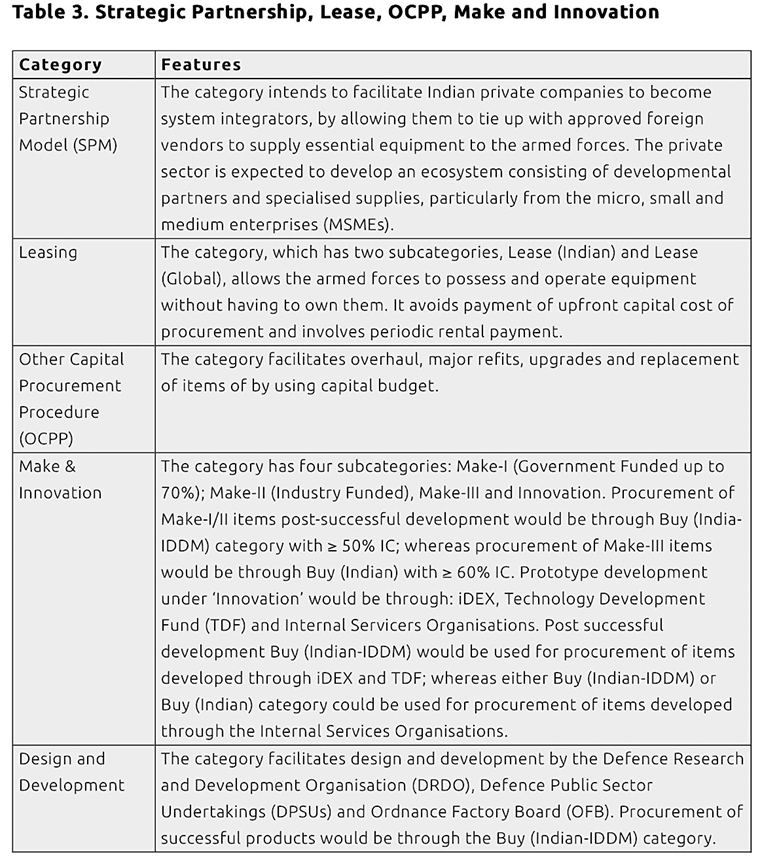
What amendments have been made to DAP 2020?
- Going forward all modernisation requirements of the Defence Services and Indian Coast Guard are to be indigenously sourced irrespective of the nature of procurement.
- Import of defence equipment/sourcing from Foreign Industry of capital acquisitions should only be an exception and undertaken with specific approval of DAC/Raksha Mantri.
- As advised by Ministry of Finance and to reduce financial burden on the Indian Defence Industry whilst maintaining financial safeguards, requirement of Integrity Pact Bank Guarantee (IPBG) has been dispensed with.
- Instead, Earnest Money Deposit (EMD) will be taken as a bid security for all acquisition cases with Acceptance of Necessity (AoN) cost more than Rs 100 crore.
- EMD is not required from Micro and Small Enterprises (MSEs).
- To encourage wider participation and broad base indigenous defence manufacturing sector in the country, the total order quantities in acquisition cases are to be split between shortlisted vendors, wherever viable.
- To create an ecosystem which fosters innovation and encourages technology development in Defence by engaging R&D institutes, academia, industries, startups and individual innovators, the iDEX framework was launched.
- Make-II procedure of DAP-2020, involving indigenisation of defence equipment through industry funded projects at prototype development stage, has been simplified by incorporating Single Stage Composite Trials of prototypes and dispensing off with quantity vetting and scaling for initial procurements in the delegated cases.
- Post simplification, the timelines in Make-II procedure will be reduced to 101-109 weeks from an existing total time-period of 122-180 weeks.
What more Complimentary Reforms needed to make the defence acquisition faster, cheaper and friendlier to the domestic arms industry?
- Promulgation of National Security Strategy
- One of the key problems facing India’s defence acquisition has been the lack of a national security strategy (NSS), or a defence white paper, therefore subjecting defence procurement to ad hocism.
- Hence, to ensure that the acquisition flows from a clear strategy, it is imperative that the government promulgates the national security strategy, or a defence white paper, at the earliest.
- Accountability in Procurement
- In India, the Comptroller and Auditor General of India (CAG) has noticed 55 approval points (points at which a file is processed for approval by the competent authorities) across the 11 different stages of procurement before a contract is signed.
- The involvement of so many decision-makers, leads to diffusion of responsibility and dilution of accountability, ultimately resulting in delays and cost overruns in procurement.
- Hence, all procurement functions should be centralized under one administrative head to enhance accountability and ensure timely procurement.
- Dedicated Acquisition Cadre
- The present acquisition setup in the MoD has just 130-odd functionaries. In comparison, the counterparts in the UK and France each have over 10,000 dedicated functionaries.
- More importantly, while the acquisition officials in these countries are career professionals, the Indian officials are drawn from various services without prior training.
- To make their tasks even more cumbersome, officials are posted only for few years.
- Given that the acquisition is specialised task requiring expertise in contracting, finance, national and international export control laws, the government needs to create a dedicated cadre for procurement.
Source:
Geetanjali Shree
This is image of Delhi-based author Geetanjali Shree, who has become the first Indian author to win the prestigious International Booker Prize for her novel 'Tomb of Sand', published originally in Hindi in 2018 as 'Ret Samadhi'. Mainpuri-born Shree is the author of five novels and several story collections.

Her works have been translated into English, French, German, Serbian, and Korean. The 64-year-old writer said she was "completely overwhelmed" with the "bolt from the blue" as she accepted her prize. The Booker Prize is one of the best-known literary awards for fiction writing in English, including both novels and collections of short stories. It was first awarded in 1969. The International Booker Prize began in 2005. A biennial prize initially, it was then awarded for a body of work available in English, including translations. In 2015, the rules of the International prize changed to make it an annual affair.
Source:
West Nile Virus (WNV)
- Context: The Kerala health department is on alert after the death of a 47-year old from the state due to the West Nile Virus.

- The West Nile Virus is a mosquito-borne (Culex species of mosquitoes act as the principal vectors for transmission), single-stranded RNA
- It is “a member of the flavivirus genus and belongs to the Japanese Encephalitis antigenic complex of the family Flaviviridae”.
- It is transmitted by infected mosquitoes between and among humans and animals, including birds, which are the reservoir host of the virus.
- It can also spread through blood transfusion, from an infected mother to her child, or through exposure to the virus in laboratories.
- However, it is not known to spread by contact with infected humans or animals.
- The disease is asymptomatic in 80% of the infected people and in the rest 20%, the symptoms include fever, headache, fatigue, body aches, nausea, rash, and swollen glands.
- Severe infection can lead to encephalitis, meningitis, paralysis, and even death.
- The disease can be prevented by protecting one-self from mosquito bites, reducing breeding sites, controlling garbage in yards, eliminating puddles, etc.
- No vaccine or specific medicines are available for West Nile virus infection.
Source:
Image source:
Masked Aadhaar
- Context: The Ministry of Electronics and Information Technology, parent body of UIDAI had recently recommended the use of Masked Aadhaar to avoid misuse.
- Masked Aadhaar is an extra layer of protection on the Aadhaar card, that masks the Aadhaar number in the downloaded e-Aadhaar and only shows the last four digits of Aadhaar number and masking the first eight.
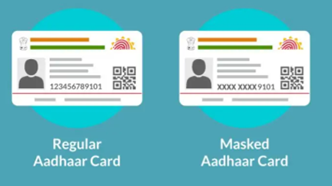
- An Aadhaar number consists of 12 digits. Masking an Aadhaar number means replacing the first eight digits with some characters like "xxxx-xxxx" while only the last four digits of the original number are visible.
- The masked Aadhaar file will be password protected and one can open the file by entering the first four letters of their name.
- Masked Aadhaar can be used for eKYC where sharing Aadhaar Number is not necessary.
Source:
- Centre retracts caution on Aadhaar photocopies
- How to download a masked Aadhaar Card to prevent misuse?
Image source:
PM CARES for children
- Context: The Prime Minister has recently released benefits under the PM-CARES for Children Scheme.
- The PM CARES for Children Scheme was launched in 2021, by the Ministry of Women and Child Development, to support children who have lost both the parents or legal guardian or adoptive parents or surviving parent to Covid-19 pandemic, during the period from 11 March 2020 to 28 February 2022.
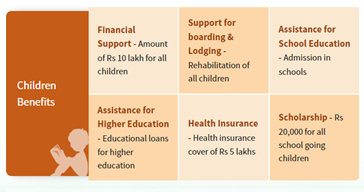
- The objective of the Scheme is to ensure comprehensive care and protection of children in a sustained manner by providing them boarding and lodging, and empowering them through education and scholarships.
- A portal named in is where the details of such children are registered.
- Benefits under Scheme include:
- 10 Lakh Fixed Deposit in the name of the child on reaching 18 years, which will be used to give a monthly stipend, until the child gets full corpus after reaching 23 years of age.
- School Education for children under 10 years and between 11-18 years, which covers fees, expenditure on uniform, text books and notebooks.
- Support for Higher Education, that include assistance for obtaining loan or equivalent scholarship.
- Further, all children will be enrolled as a beneficiary under Ayushman Bharat Scheme (PM-JAY) with a health insurance cover of Rs. 5 lakhs, the premium for which until the age of 18 will be paid by PM CARES.
Source:
- Benefits under PM CARES for Children Scheme to be released by PM Modi today at 10:30 AM
- PM-CARES for Children’ scheme
Image source:
Gen Next Democracy Network program
- Context: The ten day long programme- Gen Next Democracy Network, had concluded recently.
- Gen Next Democracy Network is a program by Indian Council for Cultural Relations (ICCR), where leaders under-35, from 75 democratic countries come to India, to get a glimpse into the functioning of the Indian democracy, and to be able to show democratic idea being followed in their own countries.
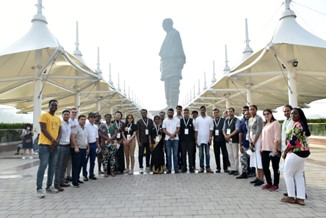
- The program is a part of celebration of 75 years of India's independence.
- The program includes information and knowledge sharing events like idea-exchange forums, seminars, visits to various governmental institutions, and cities enriched with heritage.
- This initiative comes as India has been taking a lead role in terms of the geopolitics of democracies, promoting Indian democracy, style of governance, and culture which will be a healthy step towards assuring India's capability to provide a sensible global leadership.
Source:
- India to host 'Gen Next' leaders from 75 democratic countries
- Young leaders visit India under ICCR Gen-Next Democracy Network
- Gen Next Democracy Network Programme 01/12/2021
Image source:
Building peace and prosperity with strong BRICS: The Hindu
Essence: The article, written by the Chinese ambassador to India speaks about the immense possibilities that the association of BRICS provides to the world. In the run up to the 14th BRICS Summit, the BRICS foreign ministers met and reached consensus regarding global security and development. Chinese premier has also spoken of the Global Security Initiative, to guarantee security of every nation, reduce bloc confrontation increase dialogue and partnerships for a sustainable security architecture.
Similarly, China looks forward to a Global Development Initiative to counter the threats to global economy due to the pandemic, irresponsible macro-economics and monetary policies, countering de-globalization, or unilateral sanctions/technology barriers. The leadership is appreciative of the ‘One World One Health’ concept propounded by India and wants to promote the BRICS vaccine research and development center for early warning systems for pandemic and health governance.
Since small circles can’t solve big challenges, BRICS countries could stand up to protect and safeguard the international system. BRICS looks forward to the ‘BRICS plus’ cooperation for contributing for world peace and development.
Why should you read this article?
- To know the official Chinese perspective on global issues of pandemic, security and economy.
Source:
Eight years of Nari Shakti: Indian Express
Essence: The editorial highlights the efforts of government and society to bring women force to the front for India’s socio-economic development. The ration card earlier had an exclusionary logic of identification, with its issuance to male head of the family but now, it has been replaced by gender neutral identity of Aadhar. Similarly, the revamped Rashtriya Swasthya Bima Yojana, now called as PM Jan Arogya Yojana, includes any household, even without any adult male member, includes women centric rehabilitation and removes the cap of 5 beneficiaries per family.
In the sector of financial inclusion, PM Mudra Yojana, Start Up India and Stand Up India have ensured to provide exclusive funds to women entrepreneurs. In the social development sector, having Business Correspondent Sakhis for SHG banking, Mahila Swachhagrahis to aid sanitation services, capacity building for elected women representatives (EWRs) have trained women to become the foot soldiers of change. Mahila Kisan Divas celebrations and PM Gramin Digital Sakasharta Abhiyan have been encouraging steps towards rural women empowerment.
Beti Bachao Beti Padhao campaign has led to improvement in sex ratio at birth and gross enrolment ratio in secondary and higher secondary education. Similarly, working women have been aided with National Creche Scheme and increase in paid maternity to 26 weeks. Women health also receives a boost with indoor smoke-free environment and program like Ujjwala Yojana. Abolition of triple talaq, abortion up to 24 months of gestation and a discussion on increasing age of marriage for women have been important steps to empower women.
Women right to ownership of property and assets have also been highlighted with many Awas Yojana houses being allotted to women and a record ownership of bank accounts.
Why should you read this article?
- To know the steps taken by the government to empower women in social, economic and political domains.
Source:
IBC: There's a need to bring necessary balance in the CoC’s composition: Economic Times
Essence: The Committee of creditors (CoC) supervised resolution process which is a unique aspect of insolvency under Insolvency and Bankruptcy Code (IBC) is also proving to be troublesome in assuring justice to some types of shareholders.
Even though CoC comprises both financial and operational creditors, voting is only limited to financial creditors. This leads to moral hazard in decision making in the resolution process where interest of financial creditors and other minority stakeholders gets sidelined. There is a globally accepted principle that secured creditors like financial creditors will get priority in getting their money back over unsecured creditors like equity holders and operational creditors.
Playing on this argument financial creditors are accused of adopting a risk averse approach of liquidating the assets and getting their share of the pie, even though there is a good chance of turning around the business by managing it well. This is said to be responsible for value destruction under IBC.
Recent judgements in the US have questioned this absolute primacy to secured creditors saying that it distorts the incentive of those in control of the bankruptcy process.
Voting power in CoC should be given to all the creditors - both financial and operational - having voting rights in proportion to their due amounts. Minority shareholders should be given the opportunity to present their interest before CoC finalizes the resolution plan.
Why should you read this article?
- To understand challenges with dispute resolution under Insolvency and Bankruptcy Code (IBC) and a way out.
Source:
Tortoise Conservation as Devotion
Background
While World Tortoise Day was recently commemorated to highlight the need of saving turtles and tortoises and their vanishing habitats, a temple in Kasaragod has been protecting and maintaining several tortoise species for decades.
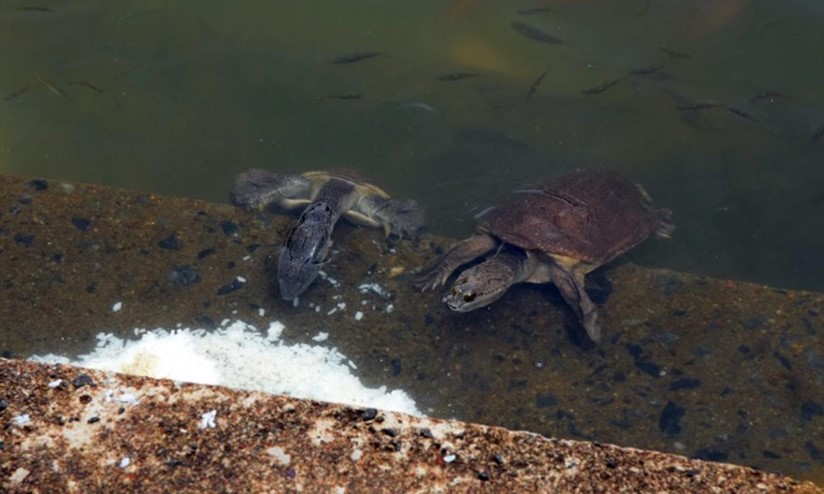
About the noble practice
- Devotees of the Thoroth Addukath Bhagavathi Temple in Molothumkavu, Bedadukka panchayat, believe that giving tortoises rice (nivedya chor) can cleanse them of their sins and heal them of skin diseases.
- The tortoises are preserved and kept in a naturally created pond (aamakulam), which is stretched across two acres of temple land.
- At the sound of a clap, tortoises emerge from the depths of the pool and consume the rice offering kept on the steps of the mandapam.
- The temple authorities and locals serve as caretakers for the tortoises, some of which are thought to be over 100 years old.
Quote: “Humankind must learn to understand that the life of an animal is in no way less precious than our own.”― Paul Oxton
Source:
Share the article
Get Latest Updates on Offers, Event dates, and free Mentorship sessions.

Get in touch with our Expert Academic Counsellors 👋
FAQs
UPSC Daily Current Affairs focuses on learning current events on a daily basis. An aspirant needs to study regular and updated information about current events, news, and relevant topics that are important for UPSC aspirants. It covers national and international affairs, government policies, socio-economic issues, science and technology advancements, and more.
UPSC Daily Current Affairs provides aspirants with a concise and comprehensive overview of the latest happenings and developments across various fields. It helps aspirants stay updated with current affairs and provides them with valuable insights and analysis, which are essential for answering questions in the UPSC examinations. It enhances their knowledge, analytical skills, and ability to connect current affairs with the UPSC syllabus.
UPSC Daily Current Affairs covers a wide range of topics, including politics, economics, science and technology, environment, social issues, governance, international relations, and more. It offers news summaries, in-depth analyses, editorials, opinion pieces, and relevant study materials. It also provides practice questions and quizzes to help aspirants test their understanding of current affairs.
Edukemy's UPSC Daily Current Affairs can be accessed through:
- UPSC Daily Current Affairs can be accessed through Current Affairs tab at the top of the Main Page of Edukemy.
- Edukemy Mobile app: The Daily Current Affairs can also be access through Edukemy Mobile App.
- Social media: Follow Edukemy’s official social media accounts or pages that provide UPSC Daily Current Affairs updates, including Facebook, Twitter, or Telegram channels.



